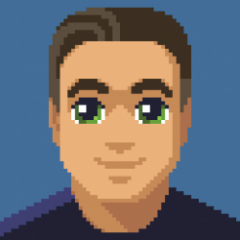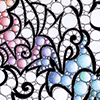Search the Community
Showing results for tags 'retopo'.
-
Hi, I was wondering if the following workflow is possible: 1: Sculpt a model using voxels and/or surface tools. 2: Use Autopo to give a nice quad topology to the mesh. 3: From the Retopo room, send the retopo object back to the Sculpt room, so you can sculpt on the retopologized mesh. I guess a workaround is to export the retopo mesh and import it into the Sculpt room, but I hope that isn't necessary. Thanks, Metin
-
I have custom hotkeys for most of my retopo tools that I use. I don't use Stack Keys or Sticky Keys. There is a function of Sticky Keys that I really, really dislike. The problem ... I have D assigned to the Points to Polygons tool. When I press D multiple times it switches to the last tool I used, then back to Points to Polygons tool. I hate this When I press D I want to know that it's selecting the Points to Polygons tool and nothing else ... ever. I assume this is part of the Sticky Keys functions. How do I disable Sticky Keys? Thanks for your help
-
Hi guys! I hope you are all fine and dandy. I am not sure if this should be in feature requests or here as it could well be an option / tick box I have missed. Is there a way to turn off vertex welding in the retopo room? I am using the retopo room to alter areas of an existing mesh via "use visible paint object as retopo" to correspond to 3d scanned objects from the sculpt room. It all seems to work really well but some of the vertices are merging when they get too close. I need the vertex number and order to stay the same for this object to work as a morph target. Has anyone else come across this "issue".? Thanks very much in advance.
- 8 replies
-
- morph targets
- vertex welding
-
(and 1 more)
Tagged with:
-
Hello guys ! I hope you have a great day ! I have a question. I need to do lot of object similar to this corbel and make them game ready. So of course i did my HP mesh and now i need to do the retopology. My question then is : With maya, how will you do the retopology of this mesh? By hand? I'm not really used to do the retopology of complex props like this one so any help will be appreciated ! https://app.gemoo.com/share/image-annotation/568558142831206400?codeId=Mp1XgXqZdLbko&origin=imageurlgenerator
-
I've been meaning to ask this question for some time... In many cases, especially when creating hard surface model shapes using Voxels, you end up with shapes which often have the nicely rounded over edges for edges which would otherwise be sharp angle. Imagine a simple form which is essentially a cube, but with those nicely "beveled" edges just as you want the model in the end to look like. In an optimized game asset workflow, the objective is often create quite low poly shapes over your HIGHRES shapes, with sharp angle edges rather than chamfered or beveled, with the intent that you will bake the HIGHRES to this retopo LOWRES, capturing the edge rounding to Normal map. In the Retopo room, how would you go about creating your sharp angle LOWRES retopo shapes, conforming to the HIGHRES shape in terms of faces/face normals, but in this case where you do not want the sharp angle edge vertices to snap to the surface (they need to remain offset)?
-
Warning: This is not a 100% reliable, completely fault proof approach. In some circumstances, the "quadrangulation" on the re-imported mesh to modeling room from sculpt room will not be completely like the original, and some manual fixing might be necessary. I discovered this after some subsequent testing, models which've been bent a lot seem to not get their topology back 1:1. You have an object in your Modeling or Retopo workspace. It is retopo geometry, so quads or mostly quads. You want to bend it around a curve, but still preserve retopo geometry, so quads not triangulated. For example, you modeled a character belt "straight", you made curve cross-section of character waist, now you want to bend the poly model belt over character's waist. Workflow: 1. Modeling / Retopo Room Of object to bend, make sure longest side points in direction world up (default Y+), shortest side in direction X+ -> goto Sculpt Room 2. Space to bring up tools, select Import tool. Select Pick from Retopo to get your object from Modeling or Retopo room. - Make sure ✅ Import w/o Voxelization ✅ No subdivision more than what you had ✅ Sculpt Tree layer to import to is "S" as in Surface Mode 3. Create Curve you want to bend to. (For example, make Cut Slice over object and produce curve from that) With object to bend in Sculpt Tree as selected Sculpt Tree layer, RMB on Curve, choose "Bend volume" Observe model is bent along curve. Adjust parameters to taste. RMB curve again when satisfied, get the Bend Volume modifier's options, select "Detach Curve Modifier". By this point you should have your bent model, except it's tris. 4. RMB on the Sculpt Tree layer with your bent mesh (Default name: Curve_CurvedBend, name produced by the bend tool) Select Retopo via decimation For the dialog box select "Don't decimate" Observe you get your bent model, still tris, as a new occurrence of item under Poly Groups 5. Select all faces of the Poly Group Title bar menu : Mesh -> Apply Quadrangulation Your model should now be quad like the original, unbent retopo mesh. (Bonus) ABOUT GETTING UVs back I can not just yet speak to whether you can also get UVs from this process, since I haven't tested yet But you might be able to get the UVs if 1. You export the UNBENT object with correct options first, and then 2. With new occurrence of bent object, import UVs that you used for your original Or possibly if you 1. Unwrap the bent object 2. Copy-paste UVs of original, unbent object.
-
HELP!! After baking my retopo to my sculpt, my mesh appears BROKEN
nuisshi posted a question in Questions & Answers
So, I made a auto retopo using zRemesher and imported the retopo into the sculpt room along with my sculpt. I turned on auto snapping and relaxed the retopo mesh. Finally, I baked in the retopo using "Bake Into Scene (microvertex)", but the result afterwards looks extremely deformed, broken, and has holes in the mesh. I feel like I've tried everything to fix this. I even adjusted the scan depth plenty of times to see whether this would solve the issue, but it did not.- 3 replies
-
- retopo
- retopomesh
-
(and 3 more)
Tagged with:
-
Hi I've just downloaded the latest version of 3DCoat - 2022.57 - and it appears the way quads are made when retopping has completely changed and... I don't like it. I can't seem to add points manually now and I've no idea how to control it. :-\ Is there any way of changing back to default? Or is there an option I need to change?
- 20 replies
-
This video goes through the process of bringing in a premade spaceship using Addon Ship Wright into Blender and then converting this to a smooth detailed object. Once spaceship is created then I will be taking this into 3DCoat to use the Wrap Tool to create a rounded Sci-Fi Object. This tutorial will help to understand how to use many tools along the way to create some cool shapes. To follow along you will need shipwright however you can create another object in different means to bring this also into 3DCoat if needed. Please join me in the process. Let me know if this helps at all. Please understand this process is very intensive with the computer so there will be a lot of waiting for things. However, things you wait for are the best things.
-
Is it possible to adjust the subdivide or smooth function?
Angry Monday posted a question in Questions & Answers
Hi all, I hope someone has an answer for this "problem" I am having. I have currently re-topologized a model inside of 3d coat 2022. I have pushed the smooth button and it looks great! Only one problem, it pushed my retopo from 410 quads to 3500. Is there a way to control this function? I have been searching for quite some time and unable to find anything. If I was able to use just %25 of what it gives me it would be spectacular! -
Here's a new retopology video, showing manual vs auto retopology with 3d coat.
-
- 1
-

-
- retopo
- retopology
-
(and 2 more)
Tagged with:
-
How do you finalise retopology in the Retopo room?
I_was_a_Bullfrog posted a topic in General 3DCoat
Hi, I've been learning 3D Coat and I'm loving it, but I can't quite figure out how to finish off the work done within the Retopo room. Could anyone tell me how I can do this? Thanks in advance! -
Here is a short video of baking a sculpt into a low poly model and then some parts of model dissapear. What is going on? What am I doing wrong? 2022-06-13 23-51-59.mp4
-
Hi, I've been following along with a video and they mention opening the Retopo Objects panel while in the Retopo mode, but for some reason, I don't seem to have it, but rather I have the Paint Objects tab where Retopo Objects should be. Does anyone know where I may be able to find it at all? Thanks in advance!
-
This is an Alien Scorpion that I have created in 3dcoat and brought into Blender for rendering. This is an asset I will be using in a scene that is off world and going to be animated. This was modeled / retopo / textured all in 3dcoat. alienscorp0001-0250.mp4
-
Hi everyone, this is a WIP and not (yet) official guide, I'm working on a tutorial that might be clear-cut method from start to finish. You can leave a comment if I'm missing something, or point out an error. Some information is entirely my own understanding, some may have been used from your own posts etc Subheading: PaintRoom --> Retopo Room --> Bake to MicroVertex --> Bake Displacement to Lowpoly mesh This Article discusses the the complete workflow(s) from model creation to Baking both Material maps and mesh of your Highly detailed Per Pixel Painting, Microvertex and Ptex Projects using Smart Materials that utilize displacement maps. 1. Displacement Topology - Preparing your model: Voxel meshes are ideal for displacement due to uniform faces that prevent painted textures on the surface from stretching and other glitches. It's also very important that your models don't contain hard edges otherwise faces will likely mix into each other creating distortion. If you need high performance in your 3D application, tris are best for game engines due to efficiency, performance and file size but Micro Vertex working with tries can create artifacts. Using Quads with Microvertex maybe more ideal to paint characters and in general quads are preferred for smoother surfaces and better deformations for animations. For Film & Game Engine Optimization that uses Automatic Frustum & Occlusion culling, plan your model. Large objects such as cliffs or walls can hide/disable other parts or areas not seen by the camera or animation viewport, so it's ideal to slice the model in such a way as allowing parts to be automatically hidden to speed up Renders and Game Performance while making visible and focusing only on what the camera actually sees. There is an essential rule of mesh resolution that needs to be followed and that is that your lowpoly model needs enough resolution initially to be subdivided from. The reason is that your model could likely be full of cracks in other programs when displacement maps are applied, it doesn't have enough actual geometry to deform (even with tessellation) You will see that smooth mesh by subdivision helps but may not fix the problem, the model needs enough resolution from the beginning of the paint job. There are a few methods of preparing your model for painting and we have it numbered from best to least under: Displacement Topology -Preparing your model, UV Mapping, Painting and Baking the Mesh. (1) Per-Pixel-Painting Topology: Ideal for landscapes -use meshes with tries (can be set upon import) Import a low poly mesh, in the menu set to "Triangulate" if using quads, set UV to "keep UV" , Subdivision can either be 0 of you want to use tessellation instead while painting (faster but lower smooth quality) or use "subdivide" (higher quality but slower to paint) If you use Subdivide 3DCoat may automatically choose a medium setting which may be sufficient. You can always add tessellation to each of your paint objects (models) later. Choose "full smoothing" if you want accuracy using Smart materials that use height maps. (2) Ptex Topology Method Topology: Ideal for Characters using quads. Upon New Ptex project topology, import model, choose" Auto-Retopo with Ptex". -It will do the the retopology for you and then send you directly to Ptex painting. (3) Micro Vertex Topology Topology- Ideal if you have to use models with quads for quality Character deformations in animations. -unless it's best and safe to convert them to tris upon import and simply export the maps but the maps might have to be exported for quads. UV Mapping: Manual UV tip: Best approach to avoid glitches is to cut UVs in a grid with straight lines, Voxel topology makes areas to cut easier to identify. Cutting into grids has equal/balanced pull on the vertices in all directions. To get more detail especially with landscapes that don't need organized UV islands, aim for islands to be square or rectangular and aligned vertical or horizontal. The more UV space filled in the better. Automatic UV Method: (1) Using Per-Pixel-Painting Mode: (Community input required for the general consensus of the best UV creation in 3DCoat -ideally with parameters that are used in the manual UV creation process) (2) Using Ptex Method Mode: The Ptex Paint method provides automatic UV mapping upon export. (3) Using Micro Vertex Mode: (Community input required for the general consensus of the best UV creation in 3DCoat -ideally with parameters that are used in the manual UV creation process) Painting Tip: When painting displacement closer to less rounded edges, reduce Depth value to approximately10 or lower, paint and test, undo, reduce or raise value, paint and test etc. Some Smart Materials contain AO, after selecting one that has AO maps you will be asked if you want to generate an AO layer because the smart material requires it. This is optional, It might be better to keep your project light, and bake AO at the end of your painting but painting with AO can help you see details better and know what you're getting right away. You can create and edit your smart materials to fine tune it. Learn about creating Smart Materials Here (You can create Smart Materials in any existing or empty project) (1) Per-Pixel-Painting: is currently the Best Method to paint Smart Materials using displacement, to understand why, visit this link (2) Ptex Painting: Since Ptex and Smart Materials have been made compatible with each other, more investigation is needed to determine if it's more advantageous over Per-Pixel-Painting but at this time it uses Quads but can it be exported to tries and still look good? (Community input required for this for the general consensus) (3) Micro Vertex Painting: Since Micro Vertex and Smart Materials have been made compatible with each other fairly recently more community input is required to determine the benefits. *Micro Vertex is compatible with creating displacement maps and "in theory" is compatible with Vector Displacement Smart Materials which should open the door to paint complete whole Colorful photo-scanned models but Smart Materials may or may not yet have added Vector Displacement Map Compatibility. A Smart Material with Vector maps maybe the first of its kind to produce Vector Displacement and Color at the same time. Baking Displacement to low poly to reduce the need for high tessellation in other 3D applications -WIP This wasn't the workflow in the past. Generally Displacement maps are created from the differences between the original and the high poly version (which is what you want) however, this is just for creating the correct displacement maps. During your painting with displacement maps used in your Smart Material, as it changes the vertex positions in the high poly it also changes some in the low poly. Bake To Hi Poly Mesh (1) Using Per-Pixel-Painting Mode: bake the displacement into a newly created high poly mesh added to a layer in the paint room using "Bake sculpt mesh onto paint room mesh" (Top Menu Under Bake) Exporting Textures: Normally when exporting textures with subdivision levels, layer o must first be selected. The (1) Using Per-Pixel-Painting Workflow: (2) Using Ptex Method Workflow: (3) Using Micro Vertex Workflow: Bake Displacement -To-Lowpoly Mesh: (1) IF you're using "Per-Pixel-Painting" send to: Retopo Room, choose "bake into scene Microvertex" then bake sculpted mesh to sub-D (you set it with option menu when bake) + displace applied mesh in paint room as polygon group name layer. (real deform high polygon mesh) (2) IF you're using "Ptex Painting" send to: The Ptex Paint method provides automatic UV mapping upon export. (3) Send Micro Vertex to: Different Displacement painting methods and evolution - what you need to know before you decide your workflow: https://3dcoat.com/wiki/index.php?title=3.1_Per_Pixel_vs_Microvertex Methods of Setting up Displacement in external applications Using traditional Methods - Adding extra geometry to instruct the shader or the program to add more vertex points and positions 1. Tessellation - Set tessellation level only as high as the details need to be. Tessellation can come in two common forms; 1.Distance-based that offers Level of detail (LOD) on the model the closer it is to the camera and 2.Full tessellation (currently used in 3DCoat) 2. Smooth mesh By Subdivision - Subdivision like full tessellation offers no ability for LOD, meaning it's going to reduce performance but like tessellation you can increase or decrease levels. It's the best visually and if tessellation doesn't close cracks due to lack of geometry, smooth mesh by subdivision might fix that. This mode is also incompatible with some GPU Renderers like Iray and will greatly slow it down. Your application may let you combine both methods; "Smoot Mesh By Subdivision" and "Tessellation." Generally using Level 1 of "Smooth Mesh By Subdivision" and "Tessellation" level between 1-2 gives optimal results for rendering. Emerging No Extra Geometry Methods 1. Screen Space Displacement mapping (SSDM) - Some initial experiments from developers have shown real-time game play of 500-1000+ FPS in Unity from the developer "Oddity Interactive" (Using the performance heavy photo-scanned RD-Textures was more in the 400 FPS range) Another Example
- 1 reply
-
- 5
-

-

-
- per pixel painting
- displacement workflow
- (and 10 more)
-
Any idea why my scale changes when baking in the retopo room. I'm baking w/PTEX. It's not always happening, but when it does, I don't know why it happens so I don't know how to work around it. In this test, the source and the target meshes are the same, just to rule out any possible discrepancies with the model, and I still get this scaling effect. The funny thing is if I do this exact same thing in Linux and set the edit scene scale to 1.0 it works fine. My Linux version is 4.8.## and my windows version is v4.9.74. I'm trying to get my coworkers to use 3d coat for baking vector displacements, but with this happening so random and no one has a good workaround, they just don't want to deal with it. Anyway, anything you can do would help. Thanks! Here are some images below.
-
Hi, How can I see a part of a retopo mesh which is under a reference mesh? Is there any option I can hide the reference mesh or make it transparent? Thanks;)
-
Have been working on a mesh retopo, everything functioning as expected. stopped for lunch, came back, had the restart 3dc. hen i reloaded the scene and continued retopo by placing pints and creating quads, suddenly the points are not snapping top the sculpt mesh but rather are being placed space somewhere beyond the surface of the mesh. Have tried restarting and the behavior persist. In the attached image you can see where I am placing the point, then in the next image with the camera pitched, you can see that it's placing the point in space behind the mesh. Sometimes it places it inside the mesh.
-
This looks very easy to do, but I have done everything I can and still haven't found a solution to this. I want to make the retopology as precise as possible. Here's a spec sheet of the model followed by what I've tried to retopo it and why it didn't work Spec sheet: -hard surface -multiple same objects duplicated and then axialed -all these objects on merged onto the same layer -each object has been rotated on every axis -the objects are very small and far apart from one and another Things I've tried to retopo this thing: -instantmesh *reason it doesn't work: the topology given gives off tris even in a model like this and adding guides to every single piece is tedious and would take weeks. Plus, navigation is very difficult because of the size and how spread out the objects are -autotopo *reason it doesn't work: the retopo mesh has a ton of errors (bumps, deformed faces, and unnecessary curves) even when the poly count is set to 30 000. I cannot delete loops with either techniques because the final topology has that many unique errors and I would have to fix them one by one. -manual points/faces *reason it doesn't work: faces end up deformed and not placed correctly, precision is non existent, not possible to simply align the camera to a perfect position because each individual object has been rotated on every axis, fixing the faces is pretty much impossible, and radial symmetry doesn't work (I have to retopo one by one)




